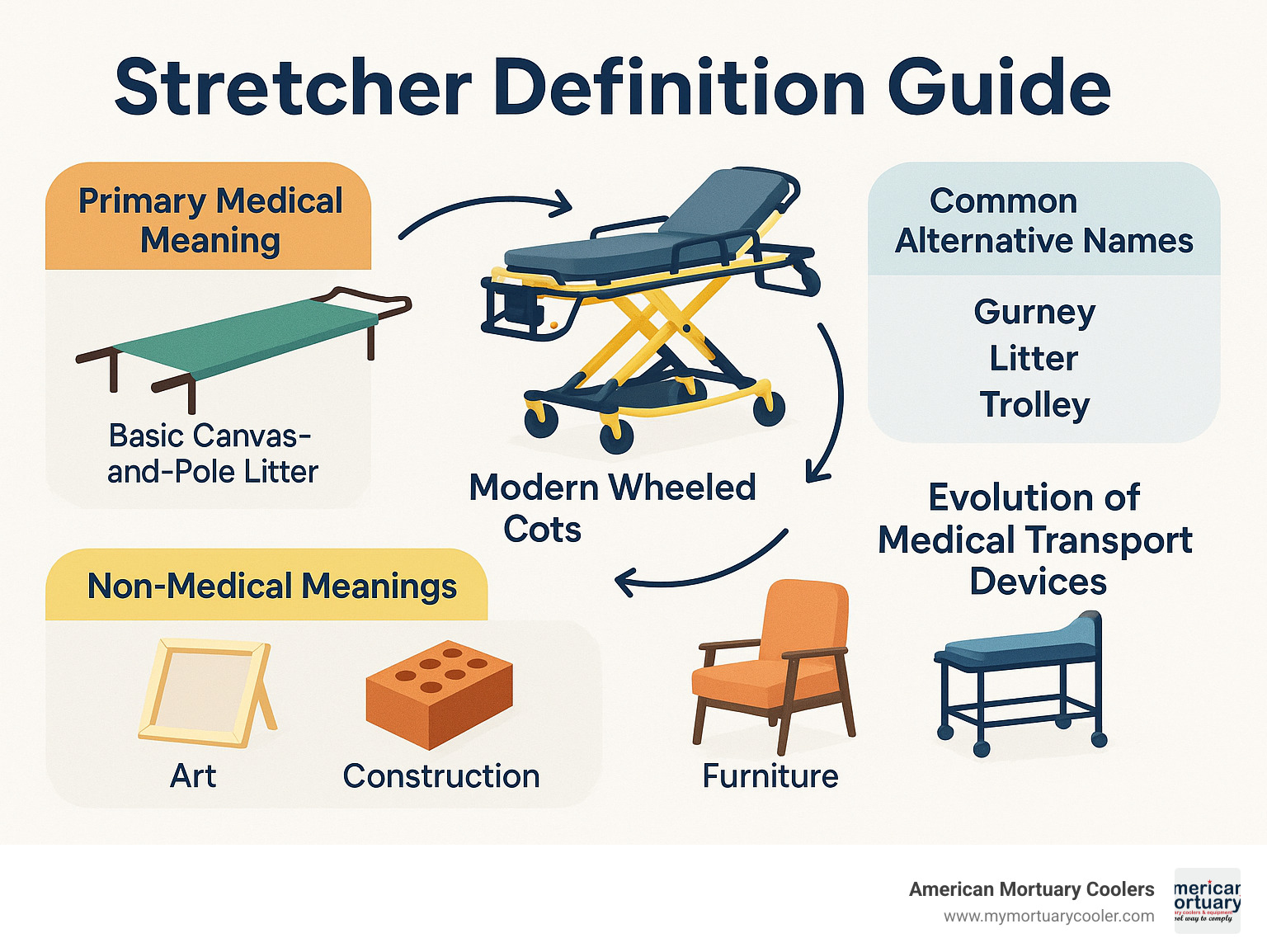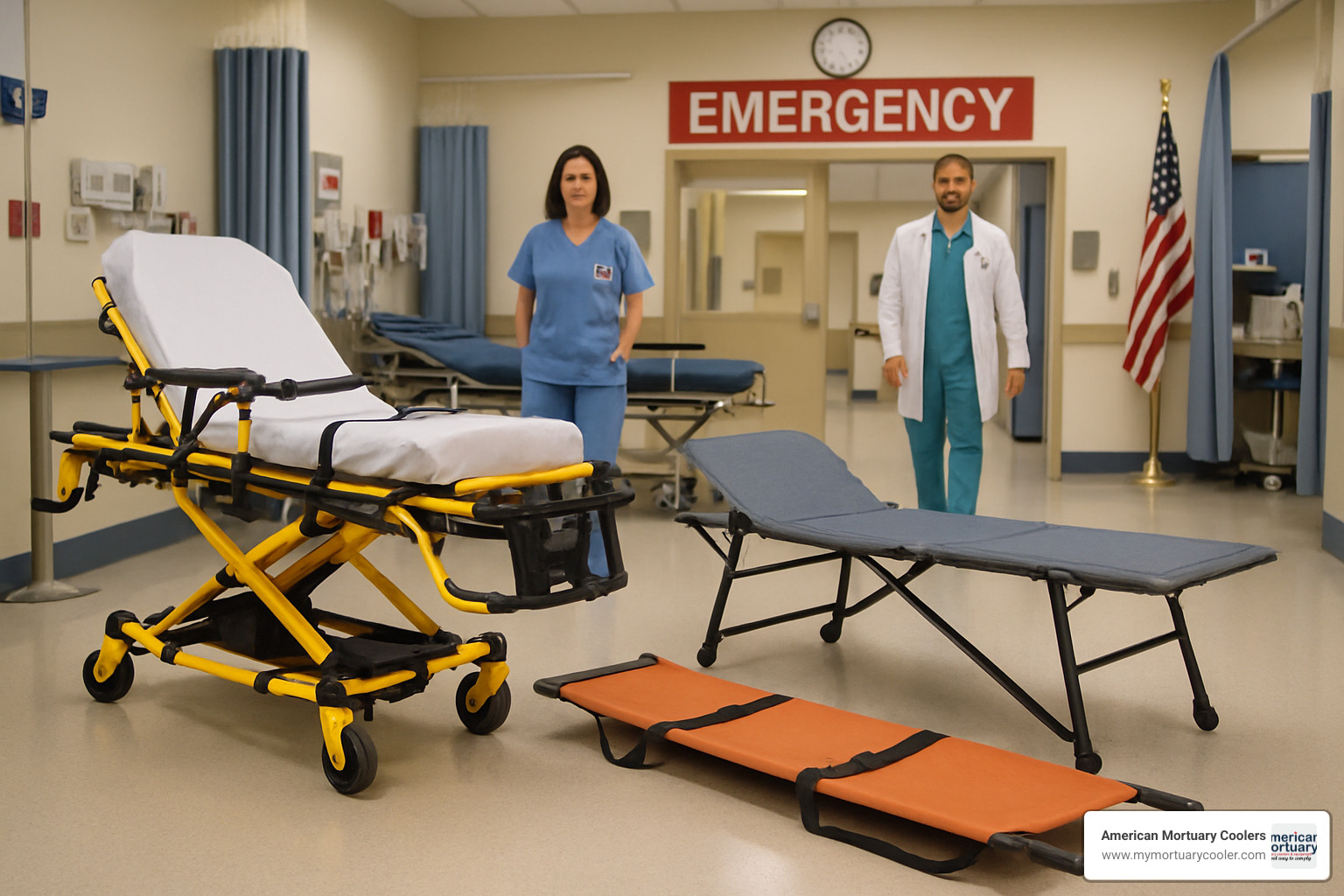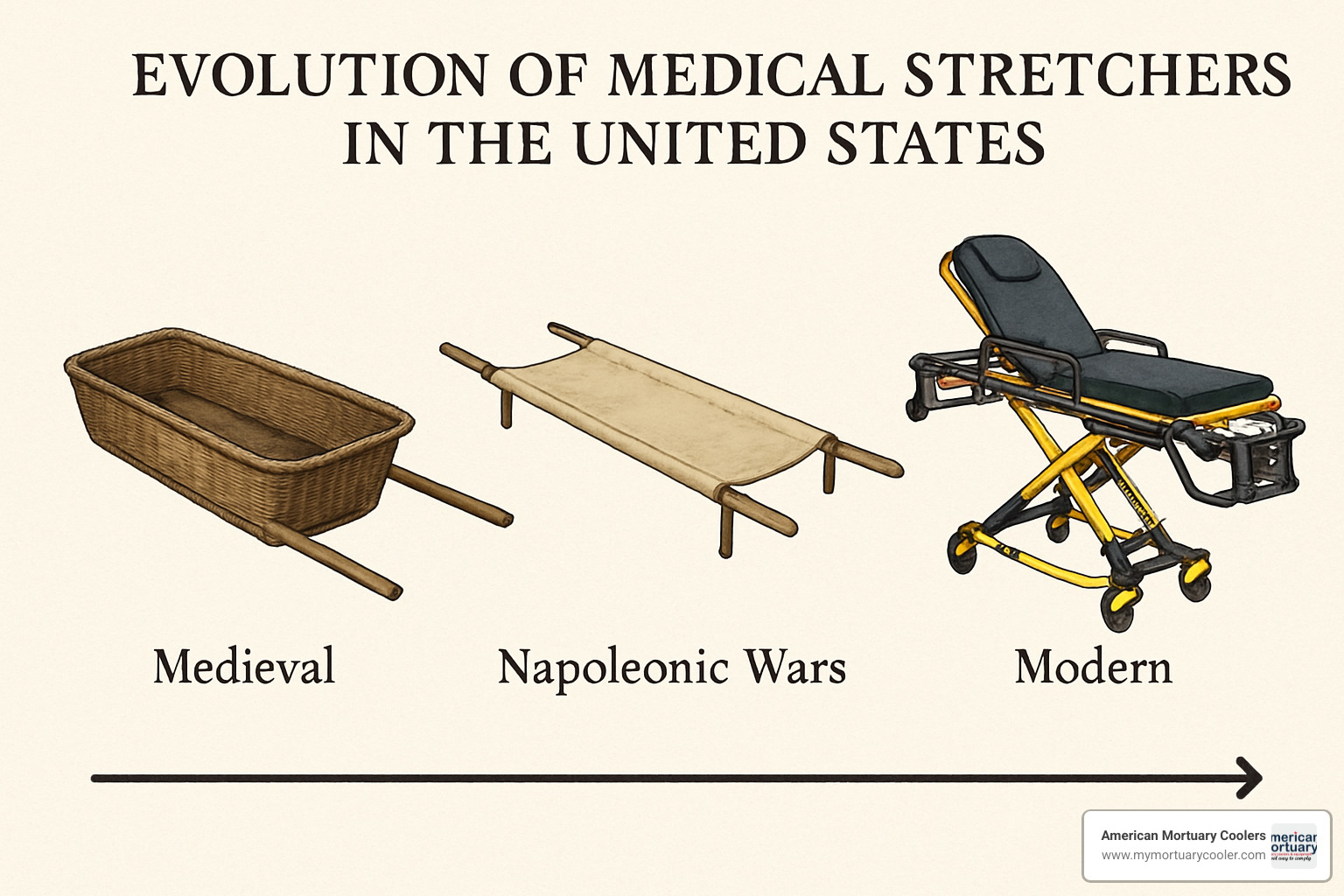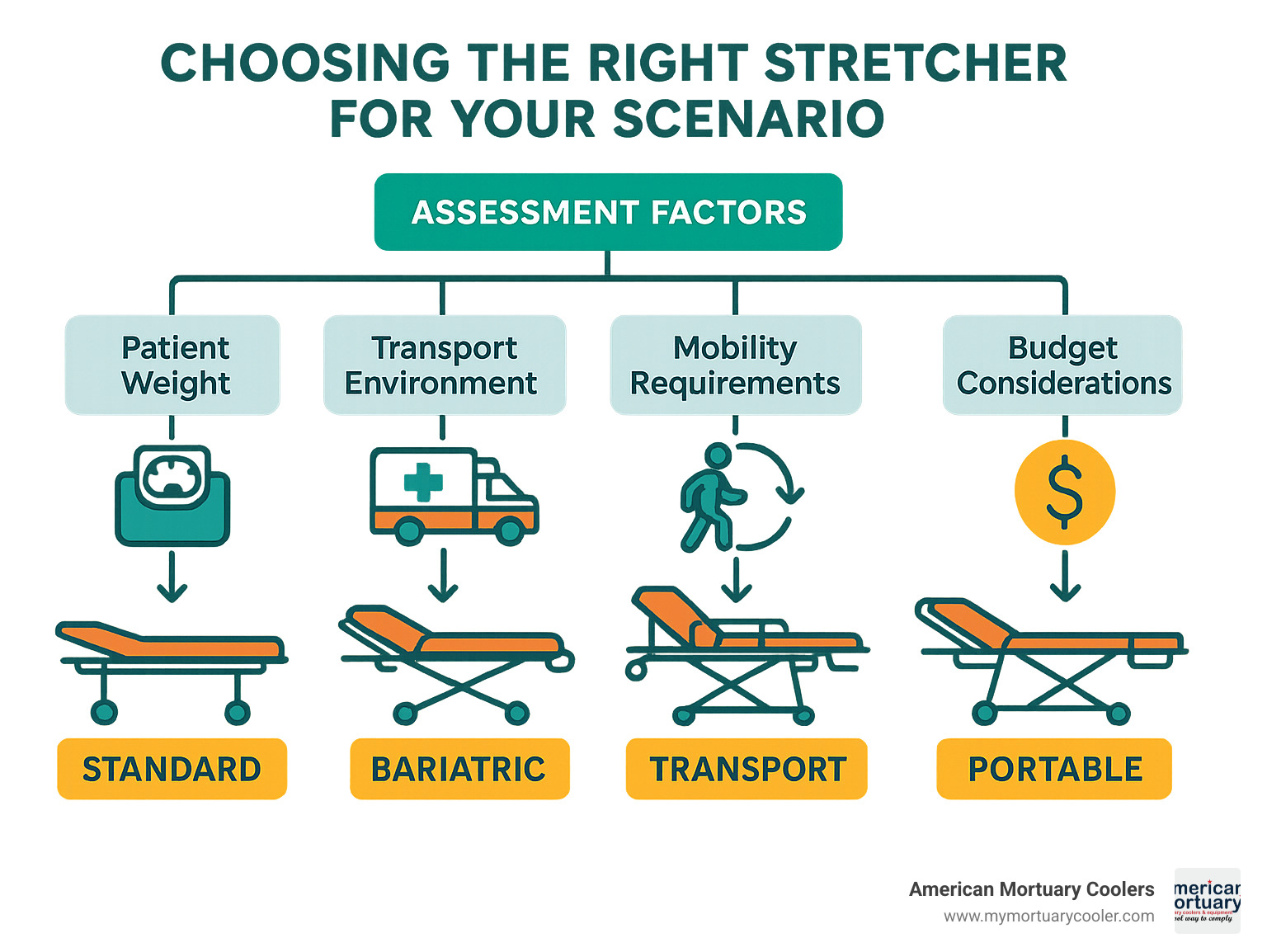Why Understanding Stretcher Definition Matters in Medical and Emergency Care
The stretcher definition encompasses far more than many people realize. At its core, a stretcher is a portable frame designed to carry individuals who cannot walk due to illness, injury, or death - but this simple device has evolved into multiple specialized forms across various industries.
Quick Definition Summary:
- Primary meaning: Medical transport device with frame and canvas/padding
- Common names: Gurney, litter, trolley, pram (regional variations)
- Key types: Basic folding, wheeled cots, scoop stretchers, basket litters
- Non-medical uses: Art canvas frames, furniture braces, masonry bricks
- Verb form: "To stretcher" someone off a field (since 1973)
The word "stretcher" dates back to the 15th century, originally describing any device that stretched or extended something. Today's medical stretchers range from simple canvas-and-pole designs used since medieval battlefields to sophisticated wheeled cots with battery-powered hydraulics and 500+ pound weight capacities.
Modern stretchers serve critical roles in emergency medical services, hospitals, morgues, and funeral homes. They've become essential tools that directly impact patient safety, worker ergonomics, and operational efficiency. Understanding the different types and their specific applications helps professionals choose the right equipment for their needs.
As American Mortuary Coolers, we've spent years helping funeral homes and medical facilities understand stretcher definition and select the most appropriate models for their operations. Our experience in mortuary equipment has shown us how crucial proper stretcher selection is for both patient dignity and staff safety.

Stretcher Definition: Medical and Beyond
When most people hear "stretcher," they picture paramedics rushing a patient into an ambulance. But the Merriam-Webster definition tells a more interesting story - this word stretches across multiple industries and meanings, far beyond the medical world.
Primary Medical Stretcher Definition
The stretcher definition in healthcare is straightforward: it's a portable device designed to carry people who can't walk due to illness, injury, or death. Think of it as a mobile bed with a lightweight frame covered in canvas, vinyl, or other tough materials stretched between supporting poles or rails.
In ambulances and hospitals, stretchers are the workhorses of patient transport. They're built to keep people safe while moving them from place to place, whether that's from an accident scene to the emergency room or between hospital departments.
Modern medical stretchers come packed with safety features like side rails to prevent falls, restraint systems for combative patients, and adjustable positioning for different medical needs. Some even have spots to attach IV poles and other medical equipment, turning them into mobile treatment stations.
What makes a good medical stretcher? Stability is key - patients need a solid, non-wobbling surface. Smooth movement matters too, since jarring motions can worsen injuries or cause pain.
Alternative Names & Regional Terminology
People call stretchers by different names depending on where they work and where they live. It's like how some folks say "soda" while others say "pop."
Gurney became the go-to term in American hospitals around the 1930s. When healthcare workers say "gurney," they usually mean the wheeled stretchers you see rolling through hospital hallways.
Trolley is what you'll hear in British hospitals. Litter has military roots and often describes the basic canvas-and-pole stretchers used on battlefields or wilderness rescues.
Cot is popular with EMS crews, particularly when talking about those fancy ambulance stretchers that can raise and lower automatically. Whether you call it a stretcher, gurney, trolley, or cot, you're talking about the same basic concept.
Non-Medical Meanings of "Stretcher"
This is where the stretcher definition gets really interesting. Step outside the medical world, and you'll find stretchers everywhere - just not the kind that carry patients.
Construction workers know stretchers as bricks laid the long way in a wall, showing their full length rather than their short end. Artists use stretchers too - those wooden frames that hold canvas tight for painting.
Furniture makers build stretchers into chairs and tables as horizontal braces between legs. Rowers push against stretchers - foot braces that give them something solid to push against while rowing.
In Australia and New Zealand, calling something a "stretcher" means it's an exaggeration or outright lie - quite a departure from the word's more literal meanings!
It's fascinating how one word can mean so many different things across various trades and industries. But they all share that core idea of something that stretches, extends, or provides structural support.
For more detailed information about medical stretcher types and applications, check out our Understanding Stretchers: Types, Uses, and Names guide.
Types of Stretchers and Key Features

When people think about stretcher definition, they often picture just one type of device. But the reality is much more interesting - medical stretchers come in many different forms, each designed to solve specific transport challenges.
Think of it like choosing the right tool for a job. You wouldn't use a hammer to turn a screw, and you wouldn't use a basic canvas stretcher to transport a 400-pound patient from an ambulance into a hospital. Let's explore the main types and what makes each one special.
| Stretcher Type | Best For | Key Features | Weight Capacity |
|---|---|---|---|
| Basic/Folding | Field rescue, tight spaces | Lightweight, portable | 250-300 lbs |
| Wheeled Cots | Hospital/EMS transport | Hydraulic height, wheels | 350-700 lbs |
| Scoop | Spinal injuries | Splits in half | 350-400 lbs |
| Basket | Mountain/technical rescue | Rigid protection | 300-600 lbs |
Basic & Folding Stretchers
The canvas-and-pole stretcher is where it all started. Picture two long poles with a piece of strong fabric stretched between them - that's your basic stretcher right there. It's simple, but don't let that fool you into thinking it's not effective.
These stretchers shine when you need something lightweight and portable. Folding joints let them collapse down to briefcase size, making them perfect for disaster response kits or military operations. When space is tight and every pound matters, these basic designs prove their worth.
The military origins of these stretchers show in their no-nonsense design. Soldiers needed something reliable that wouldn't break down in harsh conditions. Today's versions use modern materials like ripstop fabric and aluminum poles, but the core concept remains unchanged.
What makes them special? They work anywhere wheels can't go - up narrow staircases, across rough terrain, or through doorways barely wide enough for one person.
Wheeled Cots and "Gurneys"
Here's where stretcher technology gets exciting. Wheeled cots represent the high-tech end of patient transport, and they've revolutionized how medical teams work.
The star feature is variable height adjustment. Modern stretchers use battery-powered hydraulics to raise and lower patients with the push of a button. This might sound like a luxury, but it's actually a major safety advancement. EMS workers used to suffer terrible back injuries from constantly lifting heavy stretchers.
Bariatric models deserve special mention. These heavy-duty stretchers can safely transport patients weighing 500 pounds or more. They feature wider frames, reinforced construction, and more powerful hydraulic systems. As patient weights have increased over the decades, these specialized stretchers have become essential equipment.
The antler latches and locking systems might seem like small details, but they're crucial for safety. These mechanisms lock the stretcher securely into ambulance mounting systems, preventing dangerous movement during transport.
EMS ergonomics drove many of these improvements. When you're loading and unloading patients multiple times per shift, every feature that reduces physical strain makes a real difference in preventing workplace injuries.
For a deeper dive into these options, check out our guide on All About Comparing Emergency Stretcher Options.
Scoop, Basket & Flexible Stretchers
Sometimes standard stretchers just won't work. That's where these specialized designs come in, each solving problems that would stump conventional equipment.
Scoop stretchers split into two separate halves - imagine a clamshell that opens around a patient. This design lets rescuers position the stretcher without moving someone with a suspected spinal injury. The orthopedic halves slide under the patient from both sides, then lock together to create a solid transport platform.
Basket litters look like what they sound like - rigid containers that completely surround the patient. Mountain rescue teams love these because they protect patients from rocks, branches, and weather during helicopter evacuations or cliff rescues.
The Reeves sleeve takes a completely different approach. This flexible stretcher wraps around patients like a sleeping bag, providing full-body immobilization. It's perfect for confined spaces where you need to steer tight corners or narrow passages.
These specialized stretchers prove that one size definitely doesn't fit all in emergency medicine. Each design addresses specific challenges that general-purpose equipment simply can't handle.
Components That Matter
The devil is in the details when it comes to stretcher construction. Modern stretchers use aluminum alloys for their frames because they offer the best strength-to-weight ratio. Some applications require stainless steel for its superior corrosion resistance, especially in marine or chemical environments.
High-density plastics and composite frames are becoming more common as materials technology advances. These materials can be molded into complex shapes that would be expensive to machine from metal.
The mattress pads might seem like a comfort feature, but they're actually crucial for patient safety. Modern pads use antimicrobial materials that resist bacteria growth while providing pressure relief during long transports.
Side rails and restraint systems keep patients secure without making them feel trapped. The best designs allow quick release in emergencies while providing reliable security during normal transport.
IV poles and equipment mounting points turn stretchers into mobile treatment platforms. These features let medical teams continue patient care during transport rather than just moving people from point A to point B.
At American Mortuary Coolers, we understand how these components work together to create reliable, durable equipment. Our experience with mortuary stretchers has taught us that quality construction makes all the difference in daily operations.
Evolution, Materials, and Safety Standards

The story of stretcher development is really a story about human compassion meeting clever engineering. What started as desperate battlefield solutions has grown into sophisticated medical equipment that saves both patients and the backs of healthcare workers.
A Brief History of Stretchers
Medieval soldiers used wicker litters woven from branches - humanity's first organized attempt at battlefield evacuation. The Napoleonic Wars changed everything when military doctors realized that systematic patient transport could save more lives than heroic surgery. Canvas stretched between wooden poles became the standard.
World War I brought stretcher use into the modern era. The sheer number of casualties demanded efficient systems that ordinary soldiers could operate. Standardized canvas-and-pole designs emerged from this necessity.
The 1930s marked another leap forward when wheeled stretchers appeared in ambulance services. This simple addition of wheels dramatically reduced the physical demands on medical personnel while making rides smoother for patients.
Modern hydraulic systems arrived decades later, addressing the persistent problem of lifting patients safely. Battery-powered mechanisms became standard equipment as hospitals and EMS services realized how many workers were getting injured during patient transfers.
Construction Materials & Durability
Today's stretchers use materials that would amaze those early military medics. Aluminum alloys dominate modern stretcher frames because they hit the sweet spot between strength and weight. These materials resist rust while keeping the stretcher light enough for easy handling.
Stainless steel appears in components that face harsh conditions. Mortuary stretchers, like the ones we build at American Mortuary Coolers, often use stainless steel because it handles chemical exposure without degrading.
Advanced plastics have revolutionized stretcher surfaces. High-density polyethylene and similar materials clean easily while maintaining their strength. Antimicrobial coatings represent the latest advancement in stretcher hygiene, actively preventing bacterial growth.
Modern stretchers handle impressive loads. Basic models typically support 350 pounds safely, while specialized bariatric stretchers can manage over 700 pounds.
Hygiene, Maintenance & Regulations
Medical stretchers operate in a world of strict rules and careful procedures. Disinfection protocols require healthcare facilities to use EPA-approved cleaners between every patient.
FDA medical device regulations and ISO international standards govern everything from materials to manufacturing processes. Regular maintenance prevents the mechanical failures that could endanger patients.
For detailed guidance on medical stretcher standards and selection, our Medical Stretchers 101: Everything You Need to Know guide covers everything you need to consider.
The Verb "To Stretcher"
The verb "to stretcher" didn't appear until 1973, centuries after the noun form emerged in the 15th century. Sports announcers created this usage when they needed a quick way to describe injured athletes being carried off fields.
You'll almost always hear the passive construction - "he was stretchered off" rather than "they stretchered him off." The verb's recent emergence shows how medical procedures have become more visible in daily life.
Choosing the Right Stretcher for Your Scenario

Picking the right stretcher isn't just about grabbing the first one you see. It's about matching the equipment to your specific needs - and getting that match wrong can mean anything from wasted money to serious safety issues.
The key is understanding your environment, your patient population, and your budget constraints. A busy emergency room has different needs than a small funeral home, and a wilderness rescue team faces entirely different challenges than either of them.
Stretcher Definition in Decision-Making
When you truly understand the full stretcher definition - including all the different types and their specific capabilities - you can make smarter equipment choices.
Start with a basic risk assessment of your operations. What's the typical weight range of your patients? Do you work in tight spaces or open areas? Are you moving people short distances or long ones?
Budget considerations go beyond the sticker price. A cheaper stretcher that breaks down frequently or causes staff injuries will cost more in the long run than quality equipment that lasts for years.
Environmental factors matter more than most people realize. A stretcher that works perfectly in a climate-controlled hospital might fail miserably in outdoor rescue conditions.
For detailed guidance on making these comparisons, our A Practical Guide to Comparing and Buying an EMT Stretcher walks through the decision process step by step.
Common Real-World Scenarios
Sports injuries demand speed and maneuverability above all else. When someone goes down on a football field, you need equipment that can steer crowded sidelines and get to the injured player quickly. Lightweight, easy-to-carry stretchers work best here.
Bariatric transport requires specialized equipment, plain and simple. Standard stretchers rated for 350 pounds won't safely handle a 450-pound patient. Invest in proper bariatric equipment with wider frames and higher weight capacities.
Search and rescue operations face the toughest conditions imaginable. Basket litters protect patients from debris and weather, while flexible stretchers can steer tight spaces that would stop rigid designs cold.
Mortuary transfers require a different kind of consideration entirely. Here, dignity and quiet operation matter as much as functionality. Smooth, silent equipment shows respect during difficult times.
Hospital transfers within the same facility prioritize comfort and convenience. Features like smooth ride quality and adjustable positioning become important when patients might be conscious and anxious.
At American Mortuary Coolers, we've helped funeral homes across the country choose stretchers that fit their specific needs and budgets. The right equipment makes difficult situations a little easier for everyone involved.
Frequently Asked Questions about Stretchers
What's the difference between a stretcher, a hospital bed, and a spinal board?
People often confuse these three pieces of medical equipment, but each serves a very different purpose in patient care. Understanding the stretcher definition alongside these related devices helps clarify their distinct roles.
Stretchers are the workhorses of patient transport. They're built to move people safely from one place to another - whether that's from an accident scene to an ambulance, between hospital floors, or within a funeral home. Everything about their design focuses on portability and smooth movement.
Hospital beds are completely different animals. These are stationary platforms designed for extended patient stays. They come loaded with electrical controls, multiple adjustment options, and built-in systems for monitoring and treatment. You'll never see someone trying to wheel a hospital bed down a hallway - they're meant to stay put.
Spinal boards have one critical job: keeping injured spines absolutely still. These rigid, flat boards prevent any movement that could worsen spinal injuries during those crucial first minutes of care. They're not comfortable, and they're not meant to be - they're lifesavers in trauma situations.
Think of it this way: stretchers move people, hospital beds treat people, and spinal boards protect people during emergencies.
How much weight can modern stretchers safely carry?
This question comes up constantly, and the answer depends entirely on what type of stretcher you're talking about. The range is pretty dramatic, actually.
Those basic canvas stretchers you might see in disaster kits typically handle 250 to 350 pounds. They're lightweight by design, which means they have limits.
Standard wheeled cots - the ones you see in most ambulances - can safely carry 400 to 500 pounds. This covers the vast majority of patients while still being manageable for medical personnel.
Bariatric models step up the game significantly, handling 650 to 800 pounds. These specialized stretchers feature reinforced frames and wider surfaces to accommodate larger patients safely and with dignity.
For truly heavy-duty situations, specialized units can handle 1000+ pounds. These are typically custom-built for specific facilities or unusual circumstances.
Here's something crucial to remember: these weight ratings include built-in safety factors, but you should never push the limits. The patient's weight plus any attached medical equipment, IV bags, or monitors all count toward that total capacity.
How are stretchers cleaned between patients?
Proper cleaning isn't just about appearances - it's literally a matter of life and death when it comes to preventing infection transmission. The process is more thorough than most people realize.
First, everything disposable comes off - covers, sheets, any single-use attachments. This stuff goes straight into medical waste disposal.
Then comes the real cleaning. Staff use EPA-approved disinfectants specifically designed for medical equipment. Different facilities might use different products, but they all have to meet strict standards for killing bacteria, viruses, and other pathogens.
Some disinfectants require rinsing after they've done their job, while others can be left to air dry. Following manufacturer instructions exactly is critical here - shortcuts can literally cost lives.
Everything gets inspected during cleaning. This is when staff check for wear, damage, or mechanical issues that could affect patient safety. It's preventive maintenance disguised as housekeeping.
Finally, everything must be completely dry before the next patient. Moisture can harbor bacteria and compromise the disinfection process.
Many facilities now use disposable covers to simplify this process between patients. It's an extra cost, but it can significantly reduce turnaround time while maintaining safety standards.
At American Mortuary Coolers, we design our stretchers with easy cleaning in mind. Smooth surfaces, minimal crevices, and chemical-resistant materials make the disinfection process as straightforward as possible for funeral home staff.
Conclusion
Understanding the stretcher definition opens up a fascinating world that goes far beyond simple patient transport. From medieval battlefield litters to today's battery-powered hydraulic marvels, these devices have quietly revolutionized how we care for people in their most vulnerable moments.
What strikes me most about stretchers is how they've adapted to serve humanity's changing needs. That basic canvas-and-pole design that saved lives centuries ago? It's still saving lives today in wilderness rescues and disaster zones. Meanwhile, modern wheeled cots with their sophisticated hydraulics are protecting the backs of countless EMS workers while keeping patients safer and more comfortable.
The beauty lies in the diversity. A stretcher definition that once meant just "a thing that stretches" now encompasses everything from specialized scoop stretchers that protect spinal injury patients to bariatric models that ensure dignity for all body types. Even the language has evolved - we now "stretcher" athletes off the field, turning a noun into a verb that everyone understands.
For those of us in the funeral industry, stretchers represent something even more profound. They're about treating people with dignity during life's most difficult transitions. That's why proper equipment selection matters so much - it's not just about functionality, it's about respect.
At American Mortuary Coolers, we've seen how the right equipment makes all the difference. Based here in Tennessee, we've been crafting custom mortuary coolers and related equipment for funeral professionals across all 48 contiguous states. Our experience has taught us that quality equipment isn't just an investment in your business - it's an investment in the families you serve.
The stretcher's story isn't finished. As our population ages and medical practices continue evolving, these essential tools will keep adapting. But one thing won't change: the fundamental human need to transport people safely and with dignity when they can't do it themselves.
If you're looking to upgrade your facility's patient transport capabilities, we've put together a comprehensive resource to help. Check out our guide: More info about choosing the right medical stretcher.
















